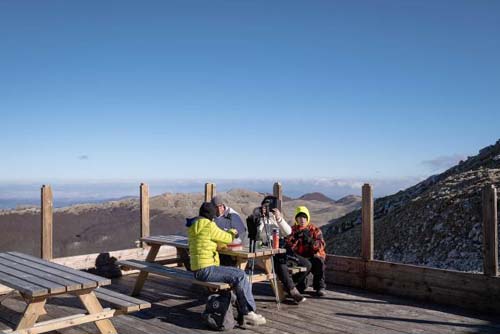
Italy: Ski resorts grapple with a snowless future
Aryn Baker
When fellow skiers sent Amadeo Reale photos of churned mud and grassy slopes at their French and Swiss ski resorts last week, he shuddered in sympathy, but felt no sense of foreboding. As the president of Cortina d’Ampezzo’s historic Sci Club 18, he is confident that Italy’s premier ski resort in the Dolomites is pretty much immune to the no-snow-pocalypse that emptied out Europe’s prime ski destinations over the winter holidays. After all, most European resorts are located at 900-1,000 meters (2,952 to 3,280 ft.) above sea level. Cortina d’Ampezzo starts at 1,600 meters (5,249 ft.) and ascends to 2,362 m (7,749 ft.). Even if the lower slopes get a little slushy from above average temperatures, as they did last week, well, there is always manufactured snow. Cortina d’Ampezzo will host the women’s world ski championships this weekend, and after five days of low temperatures and steady efforts by the resort’s snow cannons, the slopes are in perfect condition, says Reale.

A lot hinges on a steady snowpack. In February 2026 Cortina d’Ampezzo will host the Winter Olympics’ downhill events, and Reale is confident that there will be plenty of snow (manmade or natural), and enough cold weather, to make it stick. But artificial snow is only a stopgap solution, and an expensive one at that. Snow cannons only work at freezing temperatures or below. “The only thing we are scared of is having one or two months of hot weather,” he says, which is unlikely at the resort’s elevation, at least for the near future.
Over the winter holidays, though, most of Europe’s resorts got a taste of that much warmer future—the Swiss resort of Gstaad ended up flying in snow by helicopter from elsewhere in Switzerland when temperatures hit 20°C (68°) in early January. It’s not the first time Europe’s ski resorts have been without snow, but it’s the first time that snow cannons, at least since they were first deployed in the ‘80s, couldn’t make up for the shortfall because of high temperatures. This drove home the reality of winter without snow to resorts and skiers alike.

Winter sports have become a major economic engine for alpine villages that have pinned their fortunes on regular snow and the skiers that seek it out every year, spending hundreds of dollars a day in lift fees, hotels, restaurants, and equipment rentals. When there is no snow, there are no tourists, and no income. Rolando Galli says that his ski lift operation, in the Italian Apennines resort of Abetone, is down €2 million ($2.15 million) compared to this time last year, due to a lack of snow this season. For the area as a whole he estimates that it comes to about €10 million ($10.7 million) in lost lodging, dining, and shopping revenues.
While temperatures have gone back down to below freezing in most of Europe’s alpine regions this week, the climate trajectory suggests that muddy ski slopes will become a regular part of the future. Already the region has averaged a 2°C increase in temperatures since pre-industrial times, compared to the globe’s 1.2°C. That doesn’t mean there won’t be any snow, in fact, there could be increased periods of excessive snow, interspersed by bouts of rain or even hot days—extreme weather variations are as much an effect of climate change as increasing average temperatures. That doesn’t bode well for businesses, like ski resorts, that depend on reliable conditions.
